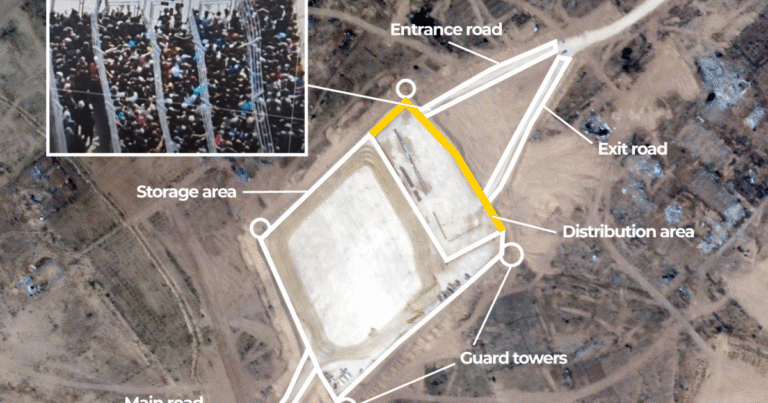Despite the GHF saying it distributed 8,000 food boxes on Tuesday, amounting to 462,000 meals, Al Jazeera correspondent Hind al-Khourdary said the rations would do little to sustain families for long.
Khoudary described a typical box with 4kg (8.8lb) of flour, a couple of bags of pasta, two cans of fava beans, a pack of tea bags and some biscuits. Other food parcels contained lentils and soup in small quantities.
“We have been dying of starvation. We have to feed our children who want to eat. What else can we do? I could do anything to feed them,” a Palestinian father told Al Jazeera. “We saw people running, and we followed them, even if it meant taking a risk, and it was scary. But fear is not worse than starvation.”
Despite her best efforts, by the time Abu Sa’da, the mother of three, made it to Rafah, it was too late.
Abu Sa’da described the experience as deeply humiliating. She was filled with shame and inferiority.
“I covered my face with my scarf the whole time. I didn’t want anyone to recognise me going to get a food parcel,” she added.
Still, Abu Sa’da says she would do it again if needed.
Limited water and electricity
Water is scarce and electricity is almost non-existent in Gaza, making it nearly impossible for people to use the limited supplies they manage to obtain.
Reporting live from Deir el-Balah, Al Jazeera correspondent Tareq Abu Azzoum explained that it is “impossible to cook any dry food in Gaza – including lentils, rice, or even pasta – without having water”.
“And if you had water, you would also need electricity or a fuel source, which have both been completely cut off entirely from Gaza,” he said.
What is the GHF?
The Gaza Humanitarian Foundation (GHF) is a newly established, US- and Israeli-approved organisation that is distributing food to Palestinians in Gaza. The organisation has already been marred with delays and difficulties, with the United Nations saying the group does not have the ability to deal with the dire humanitarian situation in Gaza, following Israel’s three-month blockade of supplies into the besieged Strip.
Under increasing pressure to lift the blockade on Gaza and allow essential supplies in, Israel has attempted to present a solution by distributing aid via the US-backed GHF. However, Jake Wood, a US military veteran overseeing the organisation, has already resigned, saying it would not be able to fulfil the principles of “humanity, neutrality, impartiality, and independence”.
The GHF “restricts aid to only one part of Gaza while leaving other dire needs unmet”, UN humanitarian chief Tom Fletcher said at the Security Council last week. “It makes aid conditional on political and military aims. It makes starvation a bargaining chip. It is a cynical sideshow. A deliberate distraction. A fig leaf for further violence and displacement.”
The UN and other humanitarian organisations have refused to work with the GHF on the basis that it would compromise values and put their teams and those receiving aid at risk. They have said the GHF can be used by Israel to forcibly displace the population by requiring them to move near a few distribution hubs or else face starvation. The UN has also opposed the use of facial recognition to vet those receiving aid.
How has Israel starved the people of Gaza?
One in five Palestinians in the Gaza Strip is facing starvation because of Israel’s nearly three-month-long blockade of the Strip. The chaos at the distribution point underscores the staggering level of hunger gripping Gaza.
According to the latest Integrated Food Security Phase Classification (IPC) report, 1.95 million people – 93 percent of the enclave’s population – are facing acute food shortages.

Certain governorates are experiencing more severe levels of hunger, namely in North Gaza.
The IPC says Israel’s continued blockade “would likely result in further mass displacement within and across governorates”, as items essential for people’s survival will be depleted.

